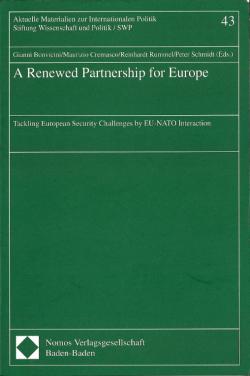A Renewed Partnership for Europe. Tackling European Security Challenges by EU-NATO Interaction

The end of the Cold War has lifted the "Iron Curtain" that divided Europe for 45 years. However, in its place new challenges have arisen that call on the continent to re-examine its security commitments and its relationship with the United States. In a four part analysis the book delves into the nature and scope of these challenges, and identifies strategies to tackle the conflicts and crises that a new Europe may present. Part one offers inside views on security scenarios and potential conflicts within the former communist bloc particularly Russia, Ukraine, Hungary and Romania. Part two analyzes the European and transatlantic institutional networks that provide a foundation for a new European security arrangement. This includes chapters on NATO, EU-WEU, the Partnership for Peace and EU-CEEC relations. Part three adds American and Russian perspectives on these institutions. Finally, the conclusion takes up the task of addressing the concepts and conditions for future EU-NATO interaction.
Volume prepared within the framework of the research project "The Interaction of the EU and NATO: Adapting Transatlantic Cooperation to the New Security Challenges in Europe" conducted by the Istituto Affari Internazionali (IAI) and Stiftung Wissenschaft und Politik (SWP). Chapter 2 published also in The International Spectator, Vol. 29., No. 1 (January-March 1994), p. 53-87.
Preface, p. 11-12
Part I. Specific Challenges to European Security
1. Nature and Classification of New Security Challenges in Europe, Ettore Greco, p. 15-38
2. Security Risks in Russia and the CIS: A Case Study, Sergei Medvedev, p. 39-73
3. Independent Ukraine: The Search for Security, Oleg Strekal, p. 75-104
4. Hungary as a Security Risk: No Major Concerns, István Szönyi, p. 105-126
5. Romanian Perspectives on Security Risks, Roxana Iorga, p. 127-152
Part II. Atlantic and European Security Arrangements
6. Current State and Future Prospects of the Euro-Atlantic Security Order, William Wallace, p. 155-170
7. The WEU after Maastricht: Trends and Perspectives, Sergei Medvedev, p. 171-196
8. Reform of the Alliance: Unfinished Business, István Szönyi, p. 197-219
9. The Puzzle of "Partnership": Cooperation or Competition?, Oleg Strekal, p. 221-243
10. The EU and the Stabilization of the CEEC: Evolving Political Relations and Economic Agreements, Roxana Iorga, p. 245-263
11. A Russian Perspective on Future European Security Arrangements, Vladimir Baranovsky, p. 265-283
12. An American Perspective on Future European Security Arrangements, Stanley R. Sloan, p. 285-304
Part III. EU-NATO Interaction
13. Security Links in the Making, Gianni Bonvicini, Maurizio Cremasco, Reinhardt Rummel, Peter Schmidt, p. 307-332
Abbreviations, p. 333-335
Contributors, p. 337


